Climbing Mount Sinai – 8 Things You Need To Know Before
Hiking Mount Sinai (2285 metres / 7,497 ft.) is one of those experiences that are on many people’s bucket list – for a reason!
The biblical Mount Sinai is one of the most important sacred places in the Jewish, Christian and Islamic religions because it is the place where a covenant between God and His people was established.
All these religions have in common that they believe the biblical Mount Sinai was the place where Moses received the Ten Commandments, which is why Mount Sinai is also referred to as Mount Moses.
The locals call it Jebel Musa in Arabic. I’m using these words interchangeably throughout this article, they all describe the same mountain.
Besides the Old Testament, it is also mentioned in the Quran, where “God prefaces a statement on the creation of Mankind by swearing to four sacred symbols:
“…by the Fig and the Olive, and the Mount of Sinai (at-Tur), and this City of security (Mecca)” (Sura 95:1-3)

Don’t confuse Mount Sinai with Mount Catherine though, which is the highest mountain in Egypt. On the peak of Mount Sinai, there is a Greek Orthodox Chapel (closed) and an open mosque,
so if you’re a practicing Muslim, this will be one of your most memorable prayer locations for sure.

Even if you’re not religious, it’s an incredible experience and you will feel the special energy in this place. It’s definitely worth doing this challenging hike.
I will not go into detail about the history and meaning of Mount Moses, as you can read that anywhere online, but will give you some practical advice instead.
For more information about Saint Catherine, read my Ultimate Guide to St. Catherine!
1. Best Season For Climbing Mount Sinai
Sinai is a hot desert climate zone, with very little rain and warm to hot temperatures throughout the year. Higher regions like St. Catherine (1600 meters) receive 4-10x more precipitation than the rest of Sinai.
So what’s the best time to do the Mount Sinai hike?
For me personally, spring is the best time to go to St. Catherine and hike Mount Moses. It’s not too hot and not too cold.
Spring is a fascinating time in the desert, as all the trees, plants, and flowers in the desert start to blossom and turn it into a green scenery you would never expect to see in a desert.
Summer and winter have their charm as well, though.

Mount Sinai in Winter
Winter can be really cold in St. Catherine, often below 0 ºC. How crazy is that, going to a desert and seeing snow?
Definitely a once-in-a-lifetime experience and an incredible photo opportunity!
On Mount Sinai, you will face extreme cold and snow is the norm, so come prepared and bring lots of warm clothes!
During the day though, the sun usually keeps you warm, even in winter.
Mount Sinai in Summer
Thanks to the high altitude, it doesn’t get much warmer than 30°C in summer, which makes Saint Catherine a perfect escape from the hot beach towns such as Dahab and Sharm El-Sheikh, or even Cairo.
Trees and fruits had time to grow and you get to taste some fresh delicacies. It’s also hot enough to dip your toes or even swim in water springs.
You will need a jacket or warm sweater at night when you hike up Mount Moses though as it’s so high, it’s simply not possible to be hot up there. It can also get pretty windy.
I have a detailed post about the best time to travel to Egypt here where I not only cover St. Catherine, but also the best seasons for other activities like scuba diving, sightseeing, a Nile Cruise etc.

2. Book a tour or go by yourself? Sunrise or Sunset?
Organized tours (mostly from Dahab and Sharm El-Sheik) climb Mount Sinai in the pre-dawn hours to view the sunrise from the summit. It gets really crowded up there!
Climbing late in the afternoon to see the sunset is a much quieter, more tranquil experience, but it has two downsides.
In summer, it can be pretty hot for such an intense hike in the sun, and you’ll be descending in the dark, which can be a bit tricky because it’s rocky terrain.

If you have enough time in Sinai, I would always recommend going without an organized tour from Sharm or Dahab. Going by yourself/with just your friends or family means you have all the time you need.
You can start your hike at any time, you can take as many breaks as you like, and you can leave the peak whenever you like.
If you’re not coming as part of a group, you can simply go to the monastery and hire a guide from the entrance.
Especially for photographers, slow hikers, or anyone with “special needs”, this is the best option.
It’s also a much more tranquil experience on the summit because you’ll get the chance to have the place all by yourself. The huge crowds on the top make it a bit busy and touristy, to be honest.
They all leave at the same time to visit the monastery when it opens at 9am, so if you stay a bit longer, it will be quiet.
You can also go up earlier to reach the peak first and watch the stars.

If you want to see the sunrise, you should start sometime between midnight and 3 am, depending on your level of fitness. Those of average fitness should be able to get to the summit in no more than three hours.
Alternatively, the sunset is also an impressive sight; for this, you should start your climb in the early afternoon.
My ultimate tip is to hike up in the afternoon and see the sunset. Then you can make yourself comfortable for the night to sleep under millions of stars.
In the last camp before the summit, you can rent mattresses and blankets so you won’t be freezing. It gets really cold so you will definitely need them.

If you don’t mind carrying a sleeping bag up, that would certainly be more hygienic. But when you’re traveling in Egypt you shouldn’t be too concerned with everything being super clean anyway, or else you’ll have a hard time here. Relax, you won’t die.
I would say your chances of being the only people on the peak of Mount Sinai the whole night are like 95%. A bit before the sun rises, you will see massive amounts of people arriving, it’s almost surreal.
Don’t sleep too long, set an alarm so that you get a good spot to see the sunrise.
3. Avoiding The Crowds At Mount Sinai Peak
As you already know, most tourists climb the mountain during the night, see the sunrise at the summit, and visit the monastery during the day.
Therefore, if you want to avoid crowds, climb the mountain for sunset or, even better, in the night before a Sunday when the monastery is closed to visitors.
There will be much less groups because they wouldn’t be able to visit the monastery in the morning.
4. How Hard Is The Mount Sinai Hike?
There are two principal routes to the summit. The longer and shallower route is called Siket El Bashait and takes about 2.5 hours by foot.
It’s also called the camel route, since, obviously, you can use a camel to get up. If you’re physically not able to do the entire Mount Sinai hike yourself, you can choose this option.
It’s not an easy hike for sure, and you probably won’t feel the need to do it again anytime soon, but it’s doable.
There are a lot of “cafés” on the way up so you have plenty of chances to take a break and have water, tea, coffee, or some snacks.

I have seen many old people with walking disabilities though who have done the hike themselves – very impressive!
They show it’s possible, and the feeling of climbing a mountain by yourself is just different than being taken up there by a camel, the sunrise or sunset is your reward and you really earned it.
So, if you’re physically able to hike, I highly recommend you do it. Go without a big group and just go slow, take as much time as you need.
The Bedouin guides are super patient and will help you with whatever you carry.
The steeper, more direct route (Siket Sayidna Musa) leads up the 3750 “steps of penitence” in the ravine behind the monastery. Both routes meet for the last part to the summit.

The first time I went, we took the camel route up and the harder route down because we wanted to see another wadi (valley). We really felt close to dying, it was a 12-hour tour in total. My legs were wobbly and shaking and I never wanted to find a bed as badly as that day.
Weirdly though, my muscles weren’t sore the next day. That really surprised me, because I’m not exercising a lot. I think it’s due to the altitude and oxygen levels? I was extremely tired though for a few days, skipping a whole night of sleep is easier when you’re 20 😉
I’d recommend you to plan in a few days of easy-going activities and do all the other hikes you might want to do around St. Catherine before you’re climbing Mount Sinai.
5. Tipping your Bedouin Guide
One thing I really want to ask everyone doing this adventure, from the bottom of my heart: Tip your Bedouin guide very generously!!!
They only get a fixed price of 650 LE (as of August 2024, always changing due to high inflation but usually equivalent to about $15) for a whole night of extreme physical work and responsibility for you.
The government sets the price, and since most people book a full tour from Dahab or Sharm, they don’t even know how much the guides earn.

It’s an absolutely ridiculous amount of money for this type of work and for the cost of living in Egypt, which is rising and rising after the devaluation of the currency.
So, please, support the local community and tip them as much as you can.
They’re also incredibly kind people and as soon as they see you struggling just a tiny bit, they offer to carry your backpack or give you their jacket if you’re cold.
They’ll do whatever they can to make the hike as easy as possible for you.
If you’re not coming with an organized group tour, you can either hire a guide straight from the entrance (it’s not allowed to go by yourself for safety reasons), or you can call or Whatsapp my friends Mohamed: +201093047096 or Jimmy (Jamal) +201093172046.
They have been my go-to guides for 6+ years now because they are both super respectful, kind, and speak great English. I always send my friends, family, and readers with them and everyone has always been so happy as they are truly good people. Tell them Hi from Christina (A Little Nomad) 🙂
6. Safety at Mount Sinai
Is climbing Mount Sinai safe? Aren’t there terrorists?
YES, it’s safe! NO, there are no terrorists!
Most people think that St. Catherine, Mount Sinai, and Sinai in general, are dangerous places. That’s because the mainstream media doesn’t distinguish between North and South Sinai.
All tourist destinations, including Mount Sinai, are located in the south of Sinai and are not more dangerous than most other parts of the world.
In the very northern part of Sinai, there used to be unrests, but luckily not anymore.
Good to know: Don’t be scared or put off by the many checkpoints all over Sinai.
The government is trying to make Sinai as safe as can be, and while the strong military presence and guns seem intimidating to Westerners at first, you have nothing to worry about. Just keep your passport handy at all times.

As soon as you arrive, you will feel the special energy in St. Catherine and the Sinai desert in general. It is absolutely magical. You immediately start to feel a sense of calmness and peace.
The media portrays Sinai as a dangerous place, but I can assure you that there are few places in the world where you feel as peaceful as here, certainly no other region in the Middle East can compare.
All the different religions actually live together in peace here, even though Egypt is predominantly a Muslim country.

I’m pretty sure you will feel right at home and perfectly safe and sound, at least the big majority of people do.
I came as a tourist and am still here 3 years later, just like many other expats, and I feel safer here than in any city in Germany or Europe, where I come from. Please, don’t let the media scare you from coming to and climbing Mount Sinai.
7. What To Pack For A Hike Up Mount Sinai

As a general rule, I would say pack as little as possible. The hike is not easy and you will regret every little thing you took that you don’t need. There are, however, a few essentials that are necessary:
- Cash – for tea, coffee, or snacks you want to consume in the cafés on the way up. Also, the mattresses and blankets to rent on the peak cost a bit of money.
- A second set of clothes – absolutely crucial since you will be arriving sweaty and it’s cold on the top. Extra pants might not be necessary, but shirts definitely are. I rarely get a cold but I did get one after the hike.
- Thermo clothes – Ideally wear some good-quality thermal clothes that dry easily, because, again, you will be sweating!
- Light scarf/hat – You will not need one at night, obviously, but at least one part of the Mount Sinai hike will be in the sun, and there’s no shade to hide. I would bring a light scarf, it’s easy to pack and it looks nice, especially when your guide wraps it around your head Bedouin-style.
- Torch or head light – The stars and the moon make it relatively bright during the night, but some parts are more covered and since it’s full of little rocks, it’s quite easy to slip when you don’t see well. A phone flashlight is not very bright, we tried, so ideally you would bring an actual torch or a head light. You can buy one in town.
What you shouldn’t bring is a lot of water. Coming from me, who easily drinks 5 liters a day, you can really believe me. I usually never leave the house without water 😉
The thing is that you feel quite full when you drink a whole lot on the way, and big bottles are heavy to carry. A half liter bottle is enough.
You can always buy water from the cafés, there are at least five or so on the way up (if you go the camel route!).
By the way, if you need to know how to get to Mount Sinai from Sharm El-Sheik, Dahab, Nuweiba, or Cairo, read my St. Catherine Guide, I explained all options in detail. If you’d like a private taxi between any cities in Sinai, my friend Mohammed has a brandnew tourist car and great prices, not overpriced like almost anything else you can book online. Just send him a message on Whatsapp: 0020 1030027891.
8. Trekking Rules In The Sinai Desert

1. Look after water
Do not pollute water sources with soap, food scraps or anything else. Do not camp within a 100 m of water sources. Wildlife needs to drink too and will be disturbed by your presence. Do not go to the toilet within 100 m of water sources.
2. Manage your waste
Crush tin cans and plastic bottles and any other waste. You brought it in so carry it out with you. If there is no toilet, BURN YOUR USED TOILET PAPER and then bury your bodily waste. You may burn paper items and you may feed vegetable waste to the camels with the owners’ permission.
3. Respect Bedouin culture and traditions
Ask permission before using wells, as these are usually private property. Only enter private gardens if invited to do so by the owner. Ask permission before taking photographs of local people. Do not burn local firewood, use only gas stoves or firewood bought in town for cooking.
4. Respect Flora and Fauna
It is prohibited to remove any object from the Protected Area including rocks, plants, and animals. It is prohibited to disturb or harm animal or birds. It is prohibited to paint or carve graffiti, cut trees or uproot plants.
St. Katherine Protectorate was declared by the Prime Ministerial Decree under Law 102 of 1983; illegal activities can result in prosecution.

Basically: Leave no traces behind, and take nothing with you.
If you have some more time in Sinai, make sure you read my guide to St. Catherine as there are plenty more amazing things to do other than climbing Mt. Sinai and visiting St. Catherine’s monastery.
Did you know that you can even sleep in the monastery? Find more insider tips in this Ultimate Guide to St. Catherine!
Climbing Mount Sinai Peak – PIN this guide for later!

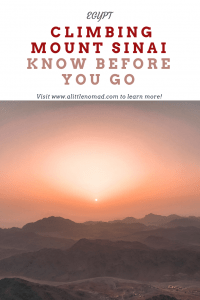
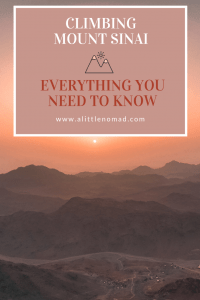
Pictures of the Mount Sinai Hike
Here are some more pictures of my Mount Sinai hike:

















Please don’t use any of these photos without my written permission.

- Best Times To Visit Egypt
- Traditional Egyptian Food
- 10 Reasons Everyone Should Visit Egypt At Least Once
- Guide to Hot Air Ballooning In Luxor
- Pyramids of Giza, Egypt – Why You Need To Visit NOW
- 5 Must-See Places in Cairo, Egypt
- 5 Mind-Blowing Secret Beaches in Egypt
- Sharm El-Sheikh: Diving Guide For Scuba Lovers
- Sharm El-Sheikh Snorkeling Guide
- 45+ Fun Things To Do In Hurghada, Egypt
- Hurghada Snorkeling Guide
- Scuba Diving Guide to El Gouna
- Ultimate Guide to St. Catherine, Sinai
- Climbing Mount Sinai – 8 Things You Need To Know Before
- 89 Things To Do in Dahab, Egypt
- Scuba Diving in Dahab – The Ultimate Guide
- Traveling to a Muslim country during Ramadan? Here’s what you need to know!

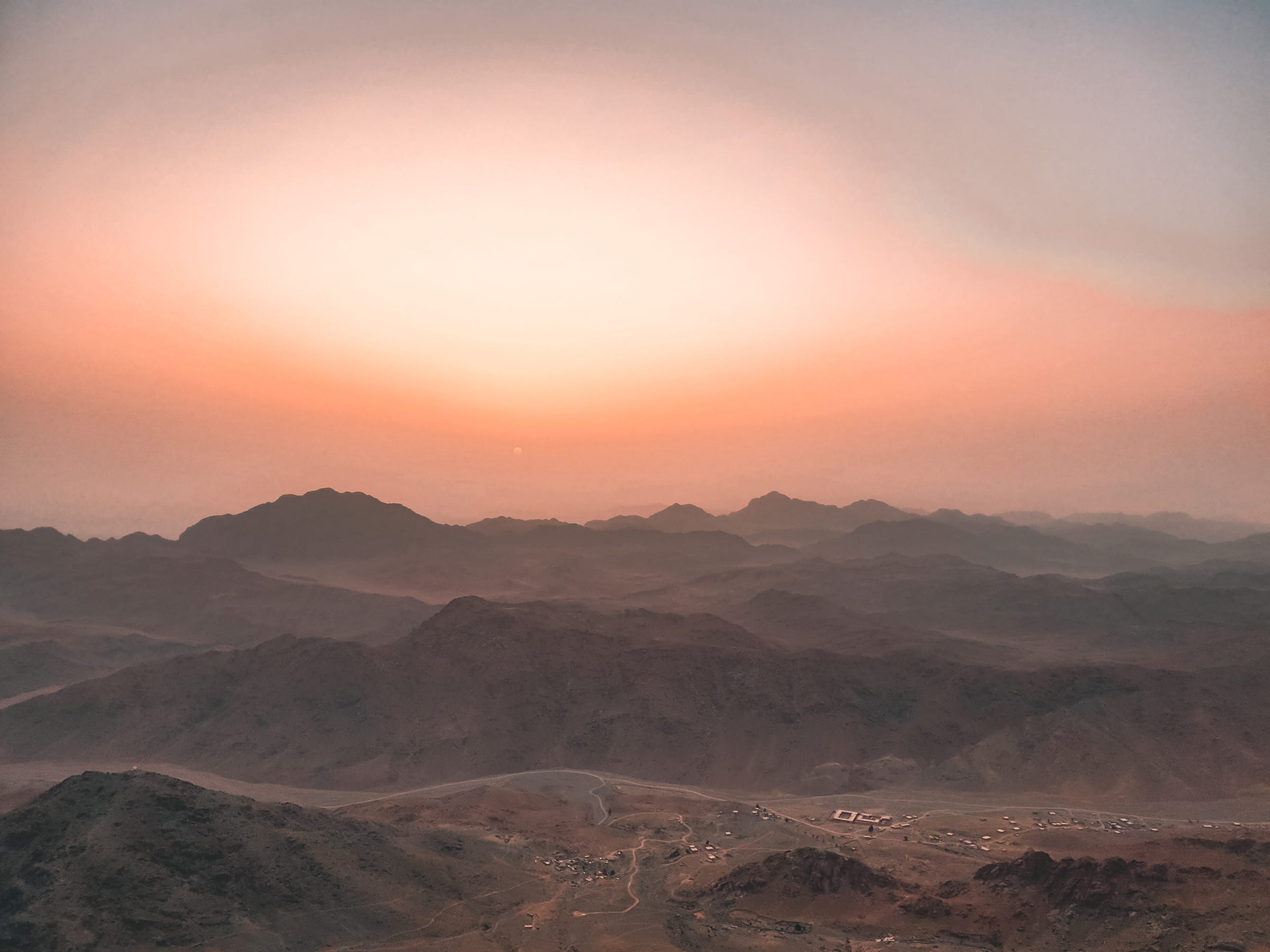
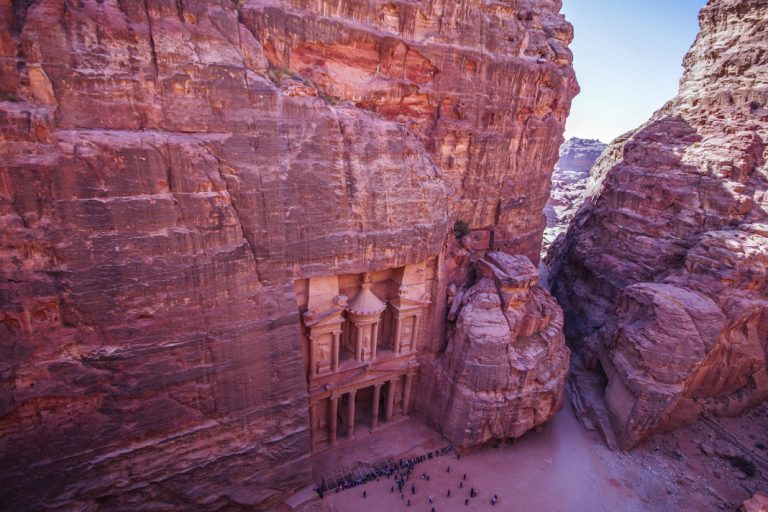


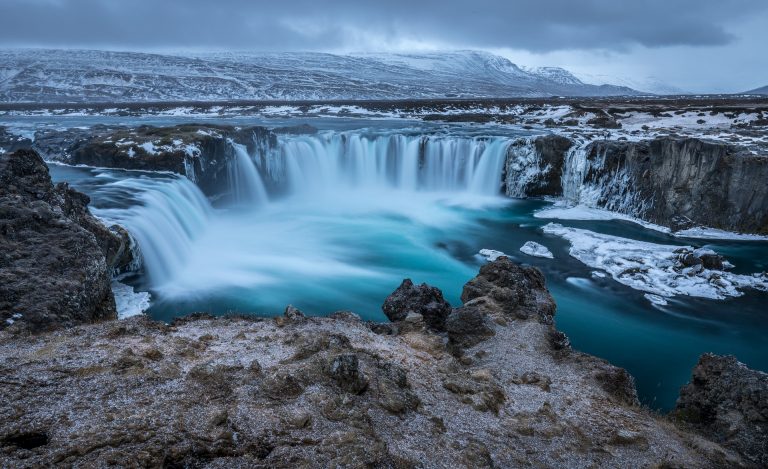


Thank you for posting this 🙂
To do the trip up Mt Sinai without an organised tour, are permits required?
Many thanks
SImon
No, you just need to hire one of the official guides at the monastery. Can’t miss them, there’s a checkpoint sort of before the monastery and the trail starts behind the monastery.